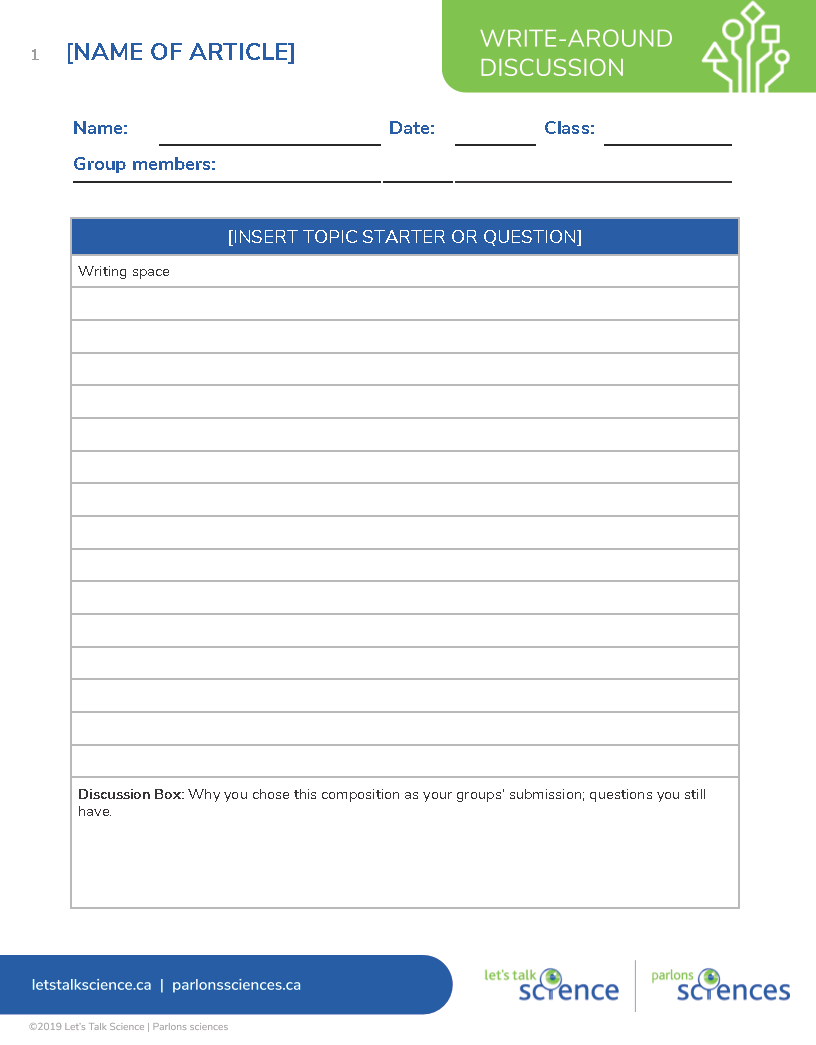Write-Around Discussion

Two girls writing (DragonImages, iStockphoto)

Two girls writing (DragonImages, iStockphoto)
How does this align with my curriculum?
PE
5
Integrated Curriculum Grade 5: Science (Draft 2023)
IS 1.4: Collaborating with others effectively can help us to share meaningful explorations in impactful ways.
PE
6
Integrated Curriculum Grade 6: Science (Draft 2023)
IS 1.4: Collaborating with others effectively can help us to share meaningful explorations in impactful ways.
PE
6
Integrated Curriculum Grade 6: Science (Draft 2023)
IS 1.4: Effectively communicate the results of their inquiry.
AB
8
Career and Technology Foundations (CTF) (revised 2019)
CTF is planning, creating, appraising and communicating in response to challenges.
AB
11
CTR2010: Job Maintenance (2016)
Job Maintenance
AB
9
Career and Technology Foundations (CTF) (revised 2019)
CTF is planning, creating, appraising and communicating in response to challenges.
MB
12
Grade 12 Career Development: Life/Work Transitioning (2017)
Unit 1: Personal Management
MB
9
Grade 9 Career Development: Life/Work Exploration (2017)
Unit 1: Personal Management
MB
10
Grade 10 Career Development: Life/Work Planning (2017)
Unit 1: Personal Management
MB
11
Grade 11 Career Development: Life/Work Building (2017)
Unit 1: Personal Management
This strategy helps small groups of students consolidate knowledge about a topic.
Why use it?
- To provide students with the opportunity to practice the skills of communication, collaboration, and critical thinking.
- To help students consolidate learning of new material by immediate use of the information.
- To help students activate prior knowledge on a topic to be discussed in class.
- To provide all students in class with an opportunity to demonstrate their understanding of a particular topic.
Tips for success
- Monitor the degree of engagement in the latter paper swaps and reduce the time accordingly if students appear to have nothing further to add.
- If used to activate prior knowledge before addressing a topic, stimulate students’ recall by posing some specific questions on the topic, reminding them of related content, or polling students on different aspects of the topic.
- If used to consolidate new learning, engage students in a review of the main topics discussed before they begin writing.
- The time provided on each subsequent pass could be increased to allow for additional reading time of the composition.
- Allow sufficient thinking time before students begin to write. Ensure students understand that some students require more processing time and that they may not get to write as much as others.
How do I use it?
- Organize students in groups of 3 to 5. Provide each student with a blank Write-Around Discussion Template.
- Assign the topic or question about which each student is to write. After giving students a short time to think about the topic, signal students to begin writing what they know about the topic. Allow 2 – 3 minutes of writing time.
- Upon the signal “PASS”, students are to immediately stop writing, even if it is in the middle of a sentence. Each student then passes his/her composition to the person on his/her right.
- Give the students the “START” signal. At this time, each student reads what was written and continues the ‘story’ by adding new content to that which was written.
- After 2 – 3 minutes, give the “PASS” signal. Once again the composition is passed to the student on his/her right. This process of writing and passing on continues until each student eventually gets his/her original paper back.
- As a group, the students then discuss each of the ‘stories’ and choose which one is most representative of the groups’ knowledge/understanding of the topic/issue.
Variations
- Go digital by having students use Google docs to write their document or compose on a laptop or tablet which is passed around.
- Each group can present their selected composition to the class. Alternately, individual members of a group could share something they learned as a result of the process.
- Students with written output difficulties could use an audio recording device which would be passed to the next person in the group.
- Instead of adding new content to the composition, students could react to the content written by asking questions, agreeing/disagreeing, writing a comment, or sharing connections of their own to the content being written.
- After the first pass of the original composition, students could alternate between adding content or reacting to the content as it is written.
Assessment
- Teachers could collect the groups’ representative writing as an exit activity.
Using this Strategy
- Write-Around Discussion-Reproducible-Template [Google doc] [PDF]
- How it works: Hydroelectric power: Write-Around Discussion reproducible [Google doc] [PDF]
- How sugar affects the brain: Write-Around Discussion reproducible [Google doc] [PDF]
- Plate Tectonics: Write-Around Discussion reproducible [Google doc] [PDF]
- The Dating Habits of Archaeologists: Write-Around Discussion reproducible [Google doc] [PDF]
- Understanding the Nitrogen Cycle: Write-Around Discussion reproducible [Google doc] [PDF]
- Why do so many people get cancer? Write-Around Discussion reproducible [Google doc] [PDF]
Create Your Own
- Write-Around Discussion-Reproducible-Template [Google doc] [PDF]
Ready to Use
- How it works: Hydroelectric power: Write-Around Discussion reproducible [Google doc] [PDF]
- How sugar affects the brain: Write-Around Discussion reproducible [Google doc] [PDF]
- Plate Tectonics: Write-Around Discussion reproducible [Google doc] [PDF]
- The Dating Habits of Archaeologists: Write-Around Discussion reproducible [Google doc] [PDF]
- Understanding the Nitrogen Cycle: Write-Around Discussion reproducible [Google doc] [PDF]
- Why do so many people get cancer? Write-Around Discussion reproducible [Google doc] [PDF]
References
Daniels H., Zemelman, S., Steineke, N. (2007). Content-area writing: Every teacher's guide. Heinemann.
